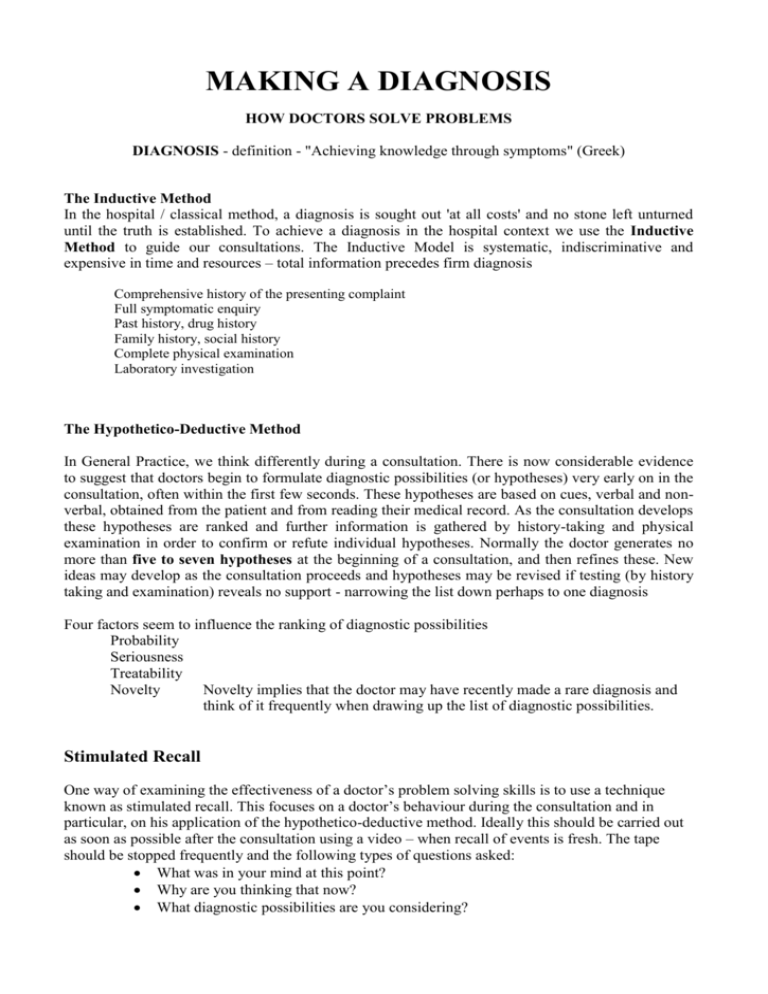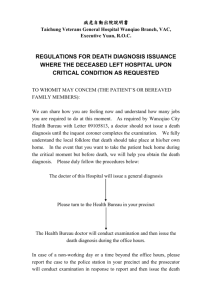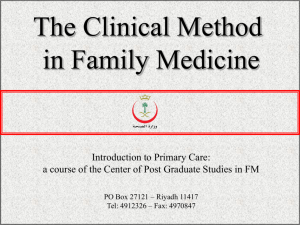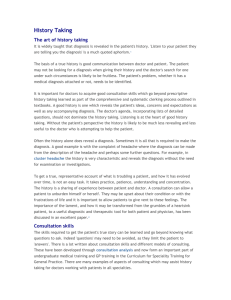MAKING A DIAGNOSIS
advertisement

MAKING A DIAGNOSIS HOW DOCTORS SOLVE PROBLEMS DIAGNOSIS - definition - "Achieving knowledge through symptoms" (Greek) The Inductive Method In the hospital / classical method, a diagnosis is sought out 'at all costs' and no stone left unturned until the truth is established. To achieve a diagnosis in the hospital context we use the Inductive Method to guide our consultations. The Inductive Model is systematic, indiscriminative and expensive in time and resources – total information precedes firm diagnosis Comprehensive history of the presenting complaint Full symptomatic enquiry Past history, drug history Family history, social history Complete physical examination Laboratory investigation The Hypothetico-Deductive Method In General Practice, we think differently during a consultation. There is now considerable evidence to suggest that doctors begin to formulate diagnostic possibilities (or hypotheses) very early on in the consultation, often within the first few seconds. These hypotheses are based on cues, verbal and nonverbal, obtained from the patient and from reading their medical record. As the consultation develops these hypotheses are ranked and further information is gathered by history-taking and physical examination in order to confirm or refute individual hypotheses. Normally the doctor generates no more than five to seven hypotheses at the beginning of a consultation, and then refines these. New ideas may develop as the consultation proceeds and hypotheses may be revised if testing (by history taking and examination) reveals no support - narrowing the list down perhaps to one diagnosis Four factors seem to influence the ranking of diagnostic possibilities Probability Seriousness Treatability Novelty Novelty implies that the doctor may have recently made a rare diagnosis and think of it frequently when drawing up the list of diagnostic possibilities. Stimulated Recall One way of examining the effectiveness of a doctor’s problem solving skills is to use a technique known as stimulated recall. This focuses on a doctor’s behaviour during the consultation and in particular, on his application of the hypothetico-deductive method. Ideally this should be carried out as soon as possible after the consultation using a video – when recall of events is fresh. The tape should be stopped frequently and the following types of questions asked: What was in your mind at this point? Why are you thinking that now? What diagnostic possibilities are you considering? In what order would you rank them? Why did you ask that particular question? Why did you perform that particular part of a physical examination? Why did you order that particular investigation? Through this method, it is possible to critically examine the doctor’s information gathering and analysing information. Such an exercise, if carried out honestly and openly, can help the doctor to learn much about their way of thinking and to develop a critical approach to their communication and problem solving skills. Existing Cues (prior knowledge of the patient) Presenting Cues Hypothesis revision No Support Provisional Diagnosis Appropriate history / exam (Further cues supplied or sought) Support Hypothesis revision Diagnosis or Problem definition Management Decisions Including investigations (further cues supplied / sought) No Support HYPOTHESIS FORMATION Outcome HYPOTHESIS TESTING






